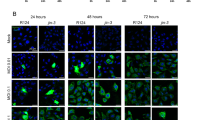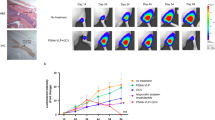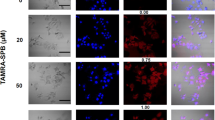Abstract
Oncolytic herpes simplex viruses type 1 (oHSVs) such as G47Δ and G207 are genetically engineered for selective replication competence in cancer cells. Several factors can influence the overall effectiveness of oHSV tropism, including HSV-1 receptor expression, extracellular matrix milieu and cellular permissiveness. We have taken advantage of human prostate organ cultures derived from radical prostatectomies to investigate oHSV tropism. In this study, we show that both G47Δ and G207 specifically replicate in epithelial cells of the prostatic glands but not in the surrounding stroma. In contrast, both the epithelial and stromal cell compartments were readily infected by wild-type HSV-1. Analysis of oHSV replication in prostate surgical specimens 3 days post infection showed that G47Δ generated ∼30-fold more viral progeny than did G207. This correlated with the enhanced expression of G47Δ-derived glycoprotein gB protein levels as compared with G207. In benign prostate tissues, G207 and G47Δ titers were notably reduced, whereas strain F titers were maintained at similar levels compared with prostate cancer specimens. Overall, our results show that these oncolytic herpes vectors show both target specificity and replication competence in human prostate cancer specimens and point to the utility of using human prostate organ cultures in assessing oHSV tropism and cellular specificity.
This is a preview of subscription content, access via your institution
Access options
Subscribe to this journal
Receive 12 print issues and online access
$259.00 per year
only $21.58 per issue
Buy this article
- Purchase on Springer Link
- Instant access to full article PDF
Prices may be subject to local taxes which are calculated during checkout



Similar content being viewed by others
References
Markert JM, Medlock MD, Rabkin SD, Gillespie GY, Todo T, Hunter WD et al. Conditionally replicating herpes simplex virus mutant, G207 for the treatment of malignant glioma: Results of a phase I trial. Gene Therapy 2000; 7: 867–874.
Mineta T, Rabkin SD, Yazaki T, Hunter WD, Martuza RL . Attenuated multi-mutated herpes simplex virus-1 for the treatment of malignant gliomas. Nat Med 1995; 1: 939–943.
Toda T, Martuza RL, Rabkin SD, Johnson PA . Oncolytic herpes simplex virus vector with enhanced MHC class I presentation and tumor cell killing. Proc Natl Acad Sci USA 2001; 98: 6396–6401.
He B, Chou J, Brandimarti R, Mohr I, Gluzman Y, Roizman B . Suppression of the phenotype of gamma(1)34.5- herpes simplex virus 1: failure of activated RNA-dependent protein kinase to shut off protein synthesis is associated with a deletion in the domain of the alpha47 gene. J Virol 1997; 71: 6049–6054.
Cassady KA, Gross M, Roizman B . The second-site mutation in the herpes simplex virus recombinants lacking the gamma134.5 genes precludes shutoff of protein synthesis by blocking the phosphorylation of eIF-2alpha. J Virol 1998; 72: 7005–7011.
Renbin L, Varghese S, Rabkin SD . Oncolytic herpes simplex virus vector therapy of breast cancer in C3(1)/SV40 T-antigen transgenic mice. Cancer Res 2005; 65: 1532–1540.
Varghese S, Newsome JT, Rabkin SD, McGeagh K, Mahoney D, Nielson T et al. Preclinical safety evaluation of G207, a replication-competent herpes simplex virus type 1, inoculated intraprostatically in mice and nonhuman primates. Hum Gene Ther 2001; 12: 999–1010.
Kelly K, Brader P, Rein A, Shah JP, Wong RJ, Fong Y et al. Attenuated multimutated herpes simplex virus-1 effectively treats prostate carcinomas with neural invasion while preserving nerve function. FASEB J 2008; 22: 1839–1848.
Walker JR, McGeagh KG, Sundaresen P, Jorgensen TJ, Rabkin SD, Martuza RL et al. Local and systemic therapy of human prostate adenocarcinoma with the conditionally replicating herpes simplex virus vector G207. Hum Gene Ther 1999; 10: 2237–2243.
Jorgensen TJ, Katz S, Wittmack EK, Varghese S, Todo T, Rabkin SD et al. Ionizing radiation does not alter the antitumor activity of herpes simplex virus vector G207 in subcutaneous tumor models of human and murine prostate cancer. Neoplasia 2001; 5: 451–556.
Chahlavi A, Rabkin S, Todo T, Sundaresan P, Martuza R . Effect of prior exposure to herpes simplex virus 1 on viral vector-mediated tumor therapy in immunocompetent mice. Gene Therapy 1999; 6: 1751–1758.
Delman KA, Bennett JJ, Zager JS, Burt BM, McAuliffe PF, Petrowsky H et al. Effects of preexisting immunity on the response to herpes simplex-based oncolytic viral therapy. Hum Gene Ther 2000; 18: 2465–2472.
Miller CG, Fraser NW . Role of the immune response during neuron-attenuated herpes simplex virus-mediated tumor destruction in a murine intracranial melanoma model. Cancer Res 2000; 60: 5714–5722.
Cattaneo R, Miest T, Shashkova EV, Barry MA . Reprogrammed viruses as cancer therapeutics: targeted, armed and shielded. Nat Rev Microbiol 2008; 6: 529–540.
Nevalainen MT, Härkönen PL, Valve EM, Ping W, Nurmi M, Martikainen PM . Hormone regulation of human prostate in organ culture. Cancer Res 1993; 53: 5199–5207.
Bronte V, Kasic T, Gri G, Gallana K, Borsellino G, Mariqo I et al. Boosting antitumor reponses of T lymphocytes infiltrating human prostate cancers. J Exp Med 2005; 201: 1257–1268.
Nevalainen MT, Valve EM, Ingleton PM, Nurmi M, Martikainen PM, Härkönen PL . Prolactin and prolactin receptors are expressed and functioning in human prostate. J Clin Invest 1997; 99: 618–627.
Berman DM, Desai N, Wang X, Karhadkar S, Reynon M, Abate-Shen C et al. Roles of hedgehog signaling in androgen production and prostate ductal morphogenesis. Dev Biol 2004; 267: 387–398.
Yu Z, Adusumilli PS, Eisenberg DP, Darr E, Ghossein RA, Li S et al. Nectin-1 expression by squamous cell carcinoma is a predictor of herpes oncolytic sensitivity. Mol Therapy 2007; 15: 103–113.
Campadelli-Fiume GC, Cocchi F, Menotti L, Lopez M . The novel receptors that mediate the entry of herpes simplex viruses and animal alphaerpesviruses into cells. Rev Med Virol 2000; 10: 305–319.
Krummenacher CA, Nicola V, Whitbeck JC, Lou H, Hou W, Lambris JD et al. Herpes simplex virus glycoprotein D can bind to poliovirus receptor-related protein 1 or herpes virus entry mediator, two structurally unrelated mediators of virus entry. J Virol 1998; 72: 7064–7074.
Guzman G, Oh S, Shukla D, Valyi-Nagy T . Nectin-1 expression in the normal and neoplastic human uterine cervix. Arch Path Lab Med 2006; 130: 1193–1195.
Choi J, Shendrik I, Peacocke M, Peehl D, Buttyan R, Ikeguchi EF et al. Expression of senescence-associated B-galactosidase in enlarged prostates from me with benign prostatic hyperplasia. Urology 2000; 56: 160–166.
Parsons JK, Gage WR, Nelson WG, De Marzo AM . P63 protein expression is rare in prostate adenocarcinoma: implications for cancer diagnosis and carcinogenesis. Urology 2001; 58: 619–624.
Sànchez R, Mohr I . Inhibition of cellular 2′-5′ oligoadenylate synthetase by the herpes simplex virus type 1 Us11 protein. J Virol 2007; 81: 3455–3464.
Sundaresan P, Hunter WD, Martuza RL, Rabkin RD . Attenuated, replication-competent herpes simplex virus type 1 mutant G207: safety evaluation in mice. J Virol 2000; 74: 3832–3841.
Kolodkin-Gal D, Zamir G, Edden Y, Pikarsky E, Pikarsky A, Haim H et al. Herpes simplex virus type 1 preferentially targets human colon carcinoma: role of extracellular matrix. J Viol 2008; 82: 999–1010.
Varghese S, Rabkin SD, Liu R, Nielsen PG, Ipe T, Martuza RL . Enhanced therapeutic efficacy of IL-12, but not GM-CSF expressing oncolytic herpes simplex virus for transgenic mouse derived prostate cancers. Cancer Gene Ther 2005; 13: 253–265.
Acknowledgements
We would like to thank Drs T. Kasic and A. Viola (University of Padova; Padova, Italy) for their helpful advice on setting up conditions for prostate organ cultures. We are grateful to Dr CA Krummenacher (University of Pennsylvania School of Dental Medicine; Philadelphia, PA, USA) for supplying the R166 antibody. We thank Dr G Fulci (Massachusetts General Hospital) for expertise on immunohistochemistry and Ms. Melissa Marinelli for laboratory assistance. RLM an SDR are consultants to MediGene Ag, which has a license from Georgetown University for G207. Support for this study was in part obtained from a grant to RLM (RO1 CA102139).
Author information
Authors and Affiliations
Corresponding author
Rights and permissions
About this article
Cite this article
Passer, B., Wu, Cl., Wu, S. et al. Analysis of genetically engineered oncolytic herpes simplex viruses in human prostate cancer organotypic cultures. Gene Ther 16, 1477–1482 (2009). https://doi.org/10.1038/gt.2009.94
Received:
Revised:
Accepted:
Published:
Issue Date:
DOI: https://doi.org/10.1038/gt.2009.94
Keywords
This article is cited by
-
A phase I/II study of triple-mutated oncolytic herpes virus G47∆ in patients with progressive glioblastoma
Nature Communications (2022)
-
Oncolytic herpes simplex virus and immunotherapy
BMC Immunology (2018)
-
Combination of vinblastine and oncolytic herpes simplex virus vector expressing IL-12 therapy increases antitumor and antiangiogenic effects in prostate cancer models
Cancer Gene Therapy (2013)
-
Advance in herpes simplex viruses for cancer therapy
Science China Life Sciences (2013)



